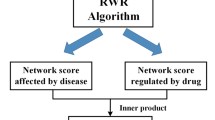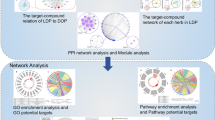Abstract
Dan Tian Jiang Zhi (DTJZ) pill is a traditional effective treatment for high blood lipid in China. It mainly consists of seven herbal medicines formulated according to traditional Chinese Medicine (TCM) practices. In this study, a network pharmacology-based strategy was used to predict the active ingredients, potential targets, signaling pathways, and investigate the “ingredient-target-pathway” mechanisms of action of DTJZ pill for the treatment of lowering blood lipids. Compounds of herbs in DTJZ pill were collected from TCMSP public database and literature. Furthermore, compounds with the oral bioavailability (OB) ≥30%, drug-likeness (DL) ≥0.18, and Caco-2 ≥0.40 were screened according to ADME features. Then, the potential targets of the active compounds were predicted by pharmacophore mapping approach and mapped with the target genes of the hypolipidemic. The compound–target network, protein–protein interaction (PPI), and compound–target–biological process network were built by Cytoscape software. The core targets were selected according to the degree values. Network analysis indicate that five target genes BMP2, APOA2, ALB, ESR1, and F2 are key nodes and play important roles in this prescription. Sixty-seven chemical compositions are screened from 909 total compounds in DTJZ pill. Among which, compounds arachidonate, Stigmasterol, Liquiritigenin, β-sitosterol, and 2-isopropyl-8-methylphenanthrene-3,4-dione play important roles in the hypolipidemic process. With the application of bioinformatics, signaling pathway enrichment, and GO biological analysis of targets were also performed. The main herb Radix Salviae could regulate blood lipid levels by participating in the adipocytokine signaling pathway, cholesterol homecostasis, and steroid metabolic biological process. Due to the interaction among diseases, genes, targets and medicines, the mechanism of multiple compounds, multitarget, and multipathway mechanisms in the cooperative treatment of hypolipidemic were demonstrated.

Traditional Chinese medicine hypolipidemic DTJZ pill generates the hypolipidemic action by affecting multiple targets and multiple pathways.





Similar content being viewed by others
References
AboulFotouh K, Allam AA, El-Badry M, El-Sayed AM (2019) A self-nanoemulsifying drug delivery system for enhancing the oral bioavailability of candesartan cilexetil: ex-vivo and in-vivo evaluation. J Pharm Sci pii: S0022-3549(19):30439–3
Antonopoulos AS, Oikonomou EK, Antoniades C, Tousoulis D (2016) From the BMI paradox to the obesity paradox: the obesity-mortality association in coronary heart disease. Obes Rev 17:989–1000
Aronne LJ (2002) Classification of obesity and assessment of obesity-related health risks. Obes Res 10:105S–115S
Bekkouch O, Harnafi M, Touiss I, Khatib S, Harnafi H, Alem C, Amrani S (2019) In vitro antioxidant and in vivo lipid-lowering properties of zingiber officinale crude aqueous extract and methanolic fraction: a follow-up study. Evid Based Complement Altern Med 2019:9734390
Beyzade S, Zhang S, Wong YK, Day IN, Eriksson P, Ye S (2003) Influences of matrix metalloproteinase-3 gene variation on extent of coronary atherosclerosis and risk of myocardial infarction. J Am Coll Cardiol 41:2130–2137
Blanco-Vaca F, Escola-Gil JC, Martin-Campos JM, Julve J (2001) Role of apoA-II in lipid metabolism and atherosclerosis: advances in the study of an enigmatic protein. J Lipid Res 42:1727–1739
Blankenberg S, Rupprecht HJ, Poirier O, Bickel C, Smieja M, Hafner G, Meyer J, Cambien F, Tiret L (2003) Plasma concentrations and genetic variation of matrix metalloproteinase 9 and prognosis of patients with cardiovascular disease. Circulation 107:1579–1585
Bogomolova AM, Shavva VS, Nikitin AA, Nekrasova EV, Dizhe EB, Larionova EE, Kudriavtsev IV, Orlov SV (2019) Hypoxia as a factor involved in the regulation of the apoA-1, ABCA1, and complement C3 gene expression in human macrophages. Biochemistry 84:529–539
Embleton JK, Pouton CW (1997) Structure and function of gastrointestinal lipases. Adv Drug Deliv Rev 25:15–32
Feng S, Dai Z, Liu AB, Huang J, Narsipur N, Guo G, Kong B, Reuhl K, Lu W, Luo Z, Yang CS (2018) Intake of stigmasterol and β-sitosterol alters lipid metabolism and alleviates NAFLD in mice fed a high-fat western-style diet. Biochim Biophys Acta Mol Cell Biol Lipids 1863:1274–1284
Grzegorzewska AE, Niepolski L, Świderska MK, Mostowska A, Stolarek I, Warchoł W, Figlerowicz M, Jagodziński PP (2018) ENHO, RXRA, and LXRA polymorphisms and dyslipidaemia, related comorbidities and survival in haemodialysis patients. BMC Med Genet 19:194
Hopkins AL (2007) Network pharmacology. Nat Biotechnol 25:1110–1111
Hopkins AL (2008) Network pharmacology: the next paradigm in drug discovery. Nat Chem Biol 11:682–690
Huang A, Fang G, Pang Y, Pang Z (2019) A Network Pharmacology Approach to Explore Mechanism of Action of Longzuan Tongbi Formula on Rheumatoid Arthritis. Evid Based Complement Alternat Med 5191362
Huang DW, Sherman BT, Lempicki RA (2009) Systematic and integrative analysis of large gene lists using DAVID bioinformatics resources. Nat Protoc 4:44–57
Jin HJ, Xie XL, Ye JM, Li CG (2013) TanshinoneIIA and cryptotanshinone protect against hypoxia-induced mitochondrial apoptosis in H9c2 cells. PLoS ONE 8:e51720
Kalaany NY, Mangelsdorf DJ (2006) LXRS AND FXR: The yin and Yang of cholesterol and fat metabolism. Annu Rev Physiol 68:159–191
Khanna AK, Rizvi F, Chander R (2002) Lipid-lowering activity of Phyllanthus niruri in hyperlipidemic rats. J Ethnopharmacol 82:19–22
Kim EJ, Jung SN, Son KH, Kim SR, Ha TY, Park MG, Jo IG, Park JG, Choe W, Kim SS, Ha J (2007) Antidiabetes and antiobesity effect of cryptotanshinone via activation of AMP-activated protein kinase. Mol Pharmacol 72:6272
Kim YW, Kim YM, Yang YM, Kay HY, Kim WD, Lee JW, Hwang SJ, Kim SG (2011) Inhibition of LXRα-dependent steatosis and oxidative injury by liquiritigenin, a licorice flavonoid, as mediated with Nrf2 activation. Antioxid Redox Sign 14:733–745.
Kopelman PG (2000) Obesity as a medical problem. Nature 404:635–643
Lei L, Zhu HY, Zhang CN, Wang XB, Ma KY, Wang LJ, Zhao YM, Chen ZY (2016) Dietary β-sitosterol is more potent in reducing plasma cholesterol than sesamin in hypercholesterolemia hamsters. Eur J Lipid Sci Tech 119:1600349
Li S, Zhang B (2013) Traditional Chinese medicine network pharmacology: theory, methodology and application. Chin J Nat Med 11:110–120
Li W, Saud SM, Young MR, Colburn NH, Hua B (2015) Cryptotanshinone, a Stat3 inhibitor, suppresses colorectal cancer proliferation and growth in vitro. Mol Cell Biochemas 406:63–73
Liang Y, Zhang C, Dai DQ (2019) Identification of differentially expressed genes regulated by methylation in colon cancer based on bioinformatics analysis. World J Gastroenterol 25:3392–3407
Lunagariya NA, Patel NK, Jagtap SC, Bhutani KK (2014) Inhibitors of pancreatic lipase: state of the art and clinical perspectives. EXCLI J 13:897–921
Ma S, Yang D, Wang K, Tang B, Li D, Yang Y (2012) Cryptotanshinone attenuates isoprenaline-induced cardiac fibrosis in mice associated with upregulation and activation of matrix metalloproteinase-2. Mol Med Rep. 6:145–150
Marrelli M, Grande F, Occhiuzzi MA, Maione F, Mascolo N, Conforti F (2019) Cryptotanshinone and tanshinone IIA from Salvia milthorrhiza Bunge (Danshen) as a new class of potential pancreatic lipase inhibitors. Nat Prod Res 20:1–4
Nozari S, Faridvand Y, Etesami A, Ahmad Khan Beiki M, Miresmaeili Mazrakhondi SA, Abdolalizadeh J (2019) Potential anticancer effects of cell wall protein fractions from Lactobacillus paracasei on human intestinal Caco-2 cell line. Lett Appl Microbiol 69:148–154
Pirillo A, Catapano AL (2015) Berberine, a plant alkaloid with lipid- and glucose-lowering properties: From in vitro evidence to clinical studies. Atherosclerosis 243:449–461
Rahman N, Jeon M, Song HY, Kim YS (2016) Cryptotanshinone, a compound of Salvia miltiorrhiza inhibits pre-adipocytes differentiation by regulation of adipogenesis-related genes expression via STAT3 signaling. Phytomedicine 23:58–67
Ru J, Li P, Wang J, Zhou W, Li B, Huang C, Li P, Guo Z, Tao W, Yang Y, Xu X, Li Y, Wang Y, Yang L (2014) TCMSP: a database of systems pharmacology for drug discovery from herbal medicines. J Cheminform 6:13
Sarkar S, Engler-Chiurazzi EB, Cavendish JZ, Povroznik JM, Russel AEl, Quintana DD, Mathers PH, Simpkins JW (2019) Over-expression of miR-34a induces rapid cognitive impairment and Alzheimer’s disease-like pathology. Brain Res 8:146327
Song X, Zhang Y, Dai E, Du H, Wang L (2019) Mechanism of action of celastrol against rheumatoid arthritis: A network pharmacology analysis. Int Immunopharmacol 74:74105725
Tang H, He S, Zhang X, Luo S, Zhang B, Duan X, Zhang Z, Wang W, Wang Y, Sun Y (2016) A network pharmacology approach to uncover the pharmacological mechanism of xuanhusuo powder on osteoarthritis. Evid Based Complement Altern Med 2016:3246946
Tang Y, Li M, Wang J, Pan Y, Wu FX (2015) CytoNCA: a cytoscape plugin for centrality analysis and evaluation of protein interaction networks. BioSystems 127:67–72
Tao Y, Tian K, Chen J, Tan D, Liu Y, Xiong Y, Chen Z, Tian Y (2019) Network pharmacology-based prediction of the active compounds, potential targets, and signaling pathways involved in danshiliuhao granule for treatment of liver fibrosis. Evid Based Complement Altern Med 2019:2630357
Wang H, Zhang Y, Zhang Y, Liu W, Wang J (2019a) Cryptotanshinone inhibits lung cancer invasion via microRNA-133a/matrix metalloproteinase 14 regulation. Oncol Lett 18:2554–2559
Wang T, Zhu W, Zhang H, Wen X, Yin S, Jia Y (2019b) Integrated analysis of proteomics and metabolomics reveals the potential sex determination mechanism in Odontobutis potamophila. J Proteom 208:103482
Wu L, Wang Y, Nie J, Fan X, Cheng Y (2013) A network pharmacology approach to evaluating the efficacy of chinese medicine using genome-wide transcriptional expression data. Evid Based Complement Altern Med 2013:915343
Wu X, Peng L, Zhang Y, Chen S, Lei Q, Li G, Zhang C (2019) Identification of key genes and pathways in cervical cancer by bioinformatics analysis. Int J Med Sci 16:800–812
Yang D, Ma S, Li D, Tang B, Yang Y (2009) Angiotensin II receptor blockade improves matrix metalloproteinases/tissue inhibitor of matrix metalloproteinase-1 balance and restores fibronectin expression in rat infarcted myocardium. Biochem Biophys Res Commun 388:606–611
Yang DC, Ma ST, Tan Y, Chen YH, Li D, Tang B, Chen JS, Su XH, Li G, Zhang X, Yang YJ (2010) Imbalance of matrix metalloproteinases/tissue inhibitor of metalloproteinase-1 and loss of fibronectin expression in patients with congestive heart failure. Cardiology 116:133–141
Yuan C, Zhang X, Long X, Jin J, Jin R (2019) Effect of β-sitosterol self-microemulsion and β-sitosterol ester with linoleic acid on lipid-lowering in hyperlipidemic mice. Lipids Health Dis 18:157
Zhao GJ, Yin K, Fu YC, Tang CK (2012) The interaction of ApoA-I and ABCA1 triggers signal transduction pathways to mediate efflux of cellular lipids. Mol Med 18:149–158
Zhu X, Yang J, Zhu W, Yin X, Yang B, Wei Y, Guo X (2018) Combination of berberine with resveratrol improves the lipid-lowering efficacy. Int J Mol Sci 19:E3903
Acknowledgements
This work was supported by the Fundamental Research Funds for the Central Universities (31920190155), the program for Changjiang Scholars and Innovative Research Team in University of Ministry of Education, China (IRT_17R88) and Research Foundation in Scientific and Technological Activities for the Overseas Chinese Scholars, Guizhou Province (20180013).
Author information
Authors and Affiliations
Corresponding author
Ethics declarations
Conflict of interest
The authors declare that they have no conflict of interest.
Additional information
Publisher’s note Springer Nature remains neutral with regard to jurisdictional claims in published maps and institutional affiliations.
Rights and permissions
About this article
Cite this article
Qi, Y., Zang, R., Lu, H. et al. Network pharmacology and bioinformatics approach reveals the hypolipidemic mechanism of Dan Tian Jiang Zhi pill. Med Chem Res 29, 243–254 (2020). https://doi.org/10.1007/s00044-019-02478-3
Received:
Accepted:
Published:
Issue Date:
DOI: https://doi.org/10.1007/s00044-019-02478-3




